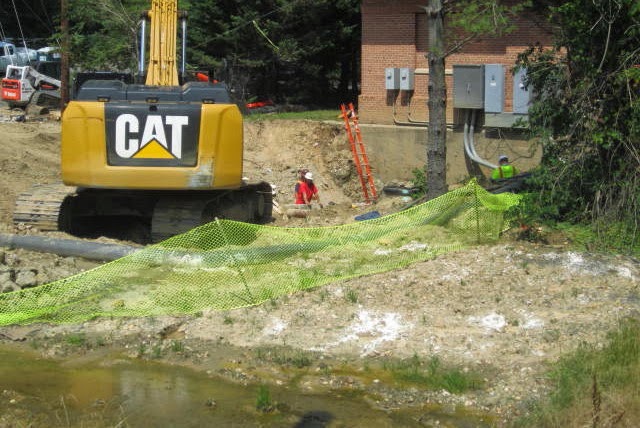Repairs under way to address sewage spills, Lake Barcroft residents assured
 |
| Work underway at the pumping station on July 8. |
The repair work to address the recent sewage spills in Lake
Barcroft is proceeding despite the apparent lack of activity at the work site in recent days, and
residents’ concerns about the possibility of additional sewage spills are
unfounded, says Charles W. de Seve, chairman of the board of trustees for the
Lake Barcroft Watershed Improvement District (WID). There had been four separate spills since April 29, dumping a total of 413,000 gallons of sewer water into the lake.
threshold for lake activity,” reports de Seve in an email sent to Lake Barcroft
residents July 8.
One resident had earlier reported seeing from her boat “a plume of
something nasty-looking” flowing from the pumping station on Sleepy Hollow Road
into the lake near the women’s garden.
spotted by kayakers near Holmes Run has anything to do with a sewer discharge
and was not visible to WID staff who investigated,” de Seve states.
County officials assured residents at the meeting that work
on fixing the pumping station would be done 24/7 and the project would be finished by July
7. “Not only have workers not been there 24/7, the job is nowhere close to being
finished,” the resident says. “It looks to me like nothing much is happening.”
stability to sewer line joints and giving the lake an extra measure of
protection.” De Seve responded in the July 8 email. At the request of county engineers,
he said, “a second engineering firm, CH2M Hill, reviewed the re-engineering of
the failed pipe joint after the final spill (as suggested in the community
meeting). Thus, the delay adds safety and does not signal a new problem nor any
failure on the part of Dewberry, the firm that did the re-engineering.”
station to be completed and the pit to be filled in by July 17. The temporary sewer
line should be removed and the site cleaned up on July 21.
curtail use of the lake, please keep in mind that the recent spills, though
carrying bacteria, were almost entirely water—the largest contained over 85 percent stormwater,”
de Seve states. “In the weeks since the spills, the flow of new water has
diluted and removed whatever sewer bacteria remained.”


Is this why it always stinks when you drive past the dam?